Just a Vegas-y two second video, but I wonder if this rain machine gives a hint of what’s coming this week at Olafur Eliasson’s MoMA/PS1 show.
Category: art
It’s A Little Abstract
Another of the things that Richard Serra said at LACMA last week has stuck with me was the artist’s call to arms for abstraction: basically, for artists in the 20th century, you’re either with us [i.e., Serra and Malevich] or you’re with the terrorists [i.e., Duchamp].

I was reminded by it, ironically, by the Times’ review of the new Tomma Abts show at the New Museum. By now, the spatial effect of seeing Abts’ arduously determined, small-scale, abstract paintings installed in large, white cubes is part of her experience. Abts’ room at the Carnegie International–which was also curated by Laura Hoptman–was an engrossing highlight; the paintings commanded the industrial space at greengrassi in London, too.] Ken Johnson writes, “Ms. Abts’s 14 small works look as though they died and went to heaven.”
But he also said, “Stylistically the paintings seem oddly out of sync with the present; they could be recently rediscovered works from the 1950s or ’60s.” That sense of anachronism seems inextricably tied to both the style–abstraction–and to the size. Though I can think of powerful exceptions, it seems like abstraction and smallness have been out of sync since WWII.

Abstractionist Thomas Nozkowski, who gets namechecked by Johnson–and whose resurgence is happening right now withfirst show after switching from Max Protetch to PaceWildenstein–talked in 2004 of deliberately choosing in the 70’s to paint on small board instead of giant canvas…
You can’t really understand artists of my generation until you factor the political atmosphere into any analysis of their work. I felt that I could no longer do big paintings that were for an audience of the very institutions that I then despised. The last thing I wanted to do was to paint for a museum, to paint for a bank lobby. I wanted to paint paintings that could fit in my friends’ rooms. So I started making 16 by 20 inch paintings that you would recognize today as my work, in 1975. These pictures, initially for political reasons, had roots in subject, in things that connected to the real world.
…and of the extremely skeptical response he received at the time, from curators, dealers, and his fellow artists:
I remember Steingrim Larssen who was then the director of the Louisiana Museum near Copenhagen coming by, and, to my surprise, he got excited about the paintings. This was 1975 or ’76, and he pulled a whole group out, said that he thought they were really interesting and then said, “Your psychiatrist told you to do these right?” He just thought it was some kind of therapy, he couldn’t imagine that this was serious work. I got a lot of that. Even Betty Parsons who was very supportive and loved young artists, she would flinch whenever I showed her a painting. So, I joined a co-op gallery to have a way to get them out of the studio and into the world.
…
There was an organization called The Organization of Independent Artists and they were attempting to subvert the gallery and museum system and all the established hierarchies. They had decided that each artist shown in their group shows would pick the next artists and so on. I was one of the artists chosen for the second show. I remember going to the organizational meeting and being told that the other artists had decided I couldn’t be in the show because the paintings weren’t serious.
Art Of Note
Andy designed this postcard for the Walker Art Center, which is cool.
But the notes on the flickr photo are even cooler.
cf. the most heavily annotated photo on flickr [kottke]
If You Wake Up To Find The Found Object Murdered, I Know Who Did It.
Richard Serra. In the Broad. With a 600-ton steel plate.
Serra’s always good for a zippy quote, and even though I’ve heard his and Lynne Cooke’s routine before, I figured it’d be worth the trip to hear them speak at LACMA tonight. [Worth the trip from our hotel in downtown LA, that is, not necessarily from NYC.]
Serra’s in town to install a wall drawing in the Broad Museum, and the “post-pop post-surrealist” collection he finds himself surrounded by has apparently been weighing on his mind. And this, a guy who knows from weight.
In 1991 or so, I got a bit too obsessed about an offhand grand unifying theory Serra tossed off at a Cy Twombly panel discussion at MoMA. [It went something like, “the 20th century is based on a misreading of Cezanne.”] When I met Serra a few years later, I mentioned that I’d been wondering what he was talking about; I think I’d hoped to be let in on some kind of secret Art History, but he didn’t remember ever saying it, and had to improvise an explanation anew.
After hearing him speak enough times, I see it’s just a habit of his to constantly try to suggest contexts for him and his work, both for us as viewers and analysts, but also for him as a viewer and student of the work that’s come before–and that’s now hanging or standing around his own.
[Tonight at LACMA, for example, he talked about how “Nauman, Hesse, Smithson, Long, and me” did this or that in response to minimalism, a conveniently historic grouping that elides Serra’s less famous colleagues in the Sixties. You know, what’s his name. Married to, uh. He actually made a reference to “your friend, who married, uh,” and Cooke correctly identified the guy.]
Anyway, as he was a guest of the institution, Serra tried, or at least pretended to try not making pitiless fun at the Duchampian “hand-me-downs” that filled the BCAM–and by implication, the current art market/scene. In the 20th century, you were either Team Malevich or Team Duchamp, and most people went with Duchamp. He said. The last words out of his mouth before the Q&A were a stage-muttered charge, calling for “the death of the found object.”
Just sayin’.
Stuck In “The Office”
I don’t know, is it a good thing to be rustled awake in the middle of the night by a compulsion to write about an exhibition you saw in December? It’s like having a flashback, only to the Elk Grove Village Marriott instead of the Hanoi Hilton.
“The Office” was curated by Ethan Sklar, director at Tanya Bonakdar Gallery, where the show ran from November 30, 2007. Given its focus on the object, material and spatial aspects of the corporate workplace, it’s worth noting that it was “downsized” in January, and was closed [let go?] on February 9th.

Like hitmen traveling to Europe, it’s the little differences that caught artists’ attention as they explored the cubicle farms and conference rooms, and some of the work has the feeling of self-consciously aestheticized, if not exoticized, souvenirs of the trip: Tim Davis’ Manet/Viacom, a 2002 photo of an emptied out office. Martin Soto Climent’s As yet untitled, a plastic venetian blind draped lyrically off the wall, and Nicole Wermers’ French Junkies #2 a lacquer and steel cube smoking station whose improbably Juddian features are immediately recognizable in the recontextualizing gallery setting.
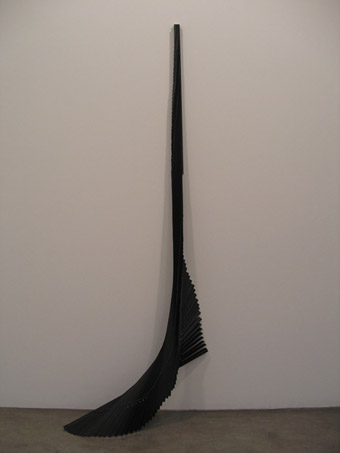
Other artists were attuned to the invisible and overlooked elements of corporate space: Jay Heikes’ The Hill Upstairs was an artfully [sic] stained fragment of a drop ceiling. While downstairs, Peter Coffin installed a generic, grey carpet with the grain set at an angle. The first round of perceptual disequilibrium was definitely physical, as if the walls weren’t plumb, but once I realized what was going on, a reflexive economic disorientation kicked in: if only he’d laid it straight, he could’ve saved 25% on that carpet, easy.
Which got to the crux of Sklar’s curatorial focus on artists exploring “products whose original form and structure [and he adds later, value] are inextricably linked to their functionality, production and utility.” By celebrating objects created or redesignated as art, whose exponentially enhanced value derives from its new-found uselessness, the gallery is the diametric opposite of the office. Or at least it’s supposed to be.
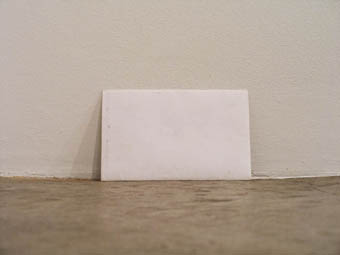
There’s an element of Surrealist perversity to “The Office”: only a very confident collector, with a very conscientious cleaning crew, could take Kris Martin’s la lettre perdue–a 5×7 envelope freshly liberated from its mundane supply room existence and thoughtfully propped against the wall–and return it to his office as his latest art world trophy.
But the irony of the show cuts both ways; after all, its second incarnation was “downsized” to make space for the gallery’s next show. Artists may be highly attuned to the aesthetic and social implications of the corporate environments other people inhabit, but in this week especially, where gallerists are busy adding their personal touches to a warren of identical cubicles at a giant trade show, the differences between “The Office” and “The Gallery” can be very little, indeed.
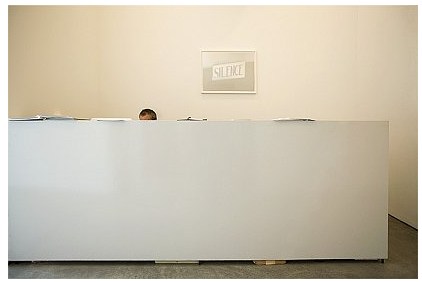
I’m reminded of the indignant reaction when Andy Freeberg showed his “Sentry” series at Danziger Projects last September. His photographs, shot on the sly, capture the uniformly daunting entrance desks of Chelsea galleries. Often, just the top of a nameless attendant’s head peeks out above the stark, minimalist cube. On his own site Freeberg wondered, “in this digital world of email and instant messaging that supposedly makes us more connected, are we also setting up barriers to the simple eye to eye contact that affirms our humanity?” Well, yeah. How else are you supposed to get any work done?
The Office, 30 Nov 2007 – 9 Feb 2008 [images via tanyabonakdargallery.com]
“Sentry,” Andy Freeberg, Sept. 6 – Oct. 13, 2007 [image via danzigerprojects.com]
Andy Freeberg – Statement [andyfreebergphotoart.com]
On Re-Creating Dan Flavin’s 1964 Green Gallery Exhibition
RC Baker gets all caught up in the spirit in reviewing Zwirner & Wirth’s re-creation of Dan Flavin’s historic 1964 exhibition at Green Gallery, the first time he exhibited only-flourescent works. The show sounds fascinating, and when combined with Flavin’s original installation sketches and documentation and a dedicated catalogue, it surpasses the one-room approximation of the show that was included in the 2005 NGA/Dia/MFAFW retrospective.
Instead of grounding the show and its reception at the time, or exploring how its details related to the artist’s later, lifelong practice, Webster just emotes about being in the space. If that’s an attempt to channel 1964 viewers’ experience, it’s unfortunately not labeled as such. And I think Webster is wrong in his description of how Flavin’s estate deals with the artist’s chosen materials, which were once off-the-shelf, but are now obsolete:
(the Flavin estate periodically commissions large batches of discontinued hues from G.E.)
When I spoke at length with Flavin’s last studio assistant, Steve Morse, who is now the conservator of the estate, for my NY Times story on Flavin’s work, he told me that in the 1980’s, there was a period when GE’s formulation changed, and they started buying up every green light bulb they could. They still have some left, or they did in 2004, anyway. But since then, the estate has documented the chemical formulation of the coating of each color of light bulb, and when it needs more, it has them fabricated in small batches. The off-the-shelf, mass-produced product had become a custom, handmade object. Almost like art.
Dan Flavin: Light White, Light Heat [vv via man]
“Dan Flavin: The 1964 Green Gallery Exhibition” runs through May 3rd [zwirnerandwirth.com]
Previously: Lights Out: The Dark Side of Success [nyt]
My interview with Stephen Flavin
Breuer’s Whitney: NFSFN
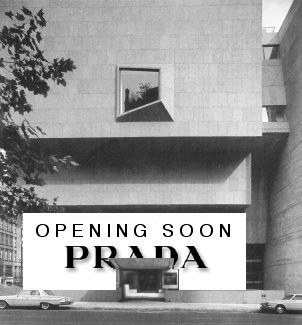
So after the Whitney opens its downtown branch, it’ll sell its Marcel Breuer building on Madison?
That’s the way I read the blueprints being unfurled in the NY Times the last couple of months. Buried in a late December story led by the Smithsonian, Robin Pogrebin first floated the idea in this lighter-than-air paragraph. It’s not even a lob; it’s a feather, and so’s the denial:
Rumors have circulated that the Whitney might consider selling its 1966 building by Breuer, but [Whitney director Adam] Weinberg dismissed the idea. “That’s not going to happen, because we love it,” he said.
Then this morning, in Carol Vogel’s piece about Leonard Lauder’s $131 million pledge, the idea of a sale came up again, this time with a time frame:
Mr. Lauder said that the money required the museum not to sell its Marcel Breuer building on Madison Avenue at 75th Street for an extended period, although he declined to specify how long.
A idea of a Breuer sale is raised repeatedly and without attribution, then quickly, but just as squishily batted down:
Although Mr. Lauder’s donation is likely to quiet rumors that the Whitney might decamp from the Breuer building, the museum’s plans remain an open question. Since the Whitney set its sights on the meatpacking district, the city’s arts world has fretted that the institution might not be able to afford two locations.
Oh, has it? I’m clearly a MoMA fanboi, so maybe I’m just out of the loop–every loop in the city’s art world–but I have never heard a rumor or a plan or even a speculation about the Whitney selling its Madison Avenue building. Nor have I heard anyone fret that the museum, which has operated up to four locations in the city at one time, might be unable to operate two.
So unless these Times reporters are totally making this up, which I doubt, where are they hearing this? From Whitney insiders? Is a deal not to sell the building “for an extended period” substantively different from a plan to sell the building after “an extended period”?
Whitney Museum to Receive $131 Million Gift [nyt]
High five to Elmgreen & Dragset for their 2001 piece, Opening Soon / Powerless Structures, Fig. 242 [via tanyabonakdargallery]
Ceci N’est Pas Un Satelloon
But darned if it isn’t pretty damn close. La Géode is a mirrored geodesic dome housing a hemispheric Omnimax theatre. It’s part of the Cité des Sciences et de l’Industrie, a science museum opened in 1986 in Parc la Villette, which I confess, I only knew as the site of Bernard Tschumi’s red follies. [There are a couple visible in the background here, and judging from this photo from another angle, they’re rightupthere next to the dome.]
At 34m across, Adrien Fainsilber’s stainless steel-clad Geode is the nearest approximation to the physical presence of a Project Echo satelloon that I’ve found. [Thanks to Stuart, actually, who tipped me to the recent post on extremely impressive shiny balls on deputy dog.]
Fainsilber’s site has more pictures, including the grainy-nice snap of the Geode nearing completion. and this amusing explanation:
Symbole de l’Univers, le reflet des nuages suggère la forme des continents et offre une vision immatérielle de l’environnement.
L’écran hémisphérique de 26m de diamètre de la salle de spectacle a engendré la forme sphérique de l’enveloppe.Symbol of the Universe, the reflection of clouds suggests the form of continents, and offers an immaterial vision of the environment.
The hemispheric screen of 26m diameter in the salle de spectacle [heh] engendered the spherical form of the envelope
I love it, a loopy mix of grandiose over-symbolism and bureaucrat-pleasing rationalization. As if the shiny steel awesomeness of the dome was somehow just the unavoidable by-product of the program the humble architect received. [Qu’est ce qu’on a pu faire? C’est logique.] Sure beats the “but it’s art!” pitch that was the last straw for the suits backing the Pepsi Pavilion.
Also, it’s an amusing stick in the eye of the deconstructionist, “form before function” conceit that Tschumi and collaborator [sic] Jacques Derrida put forward for the rest of the park.
I don’t know the story of the creation of Parc de la Villette, but Tschumi sounds like the Robert Irwin to Fainsilber’s self-important Richard Meier. Looking at the landscaping, la Geode has gone from being a Symbol of the Universe to just one stop of Tschumi’s David Rockwellian Cinematic Promenade. Or to the electron on a hydrogen atom. Which, as I zoom in with the all-seeing Google Eye to watch the picnickers in the Parc, i realize is so true. What if the whole universe were just an atom under the fingernail of a giant?

extremely impressiv shiny balls [deputydog.com]
Fainsilber > Realisations > CSI [fainsilber.com]
CSI and la Geode, and guests reading Le Monde, apparently, and letting their kids run wild [google maps]
Metaphysics of Parc de la Villette [gardenvisit.com]
Angel Dust, 2000, Jeremy Blake
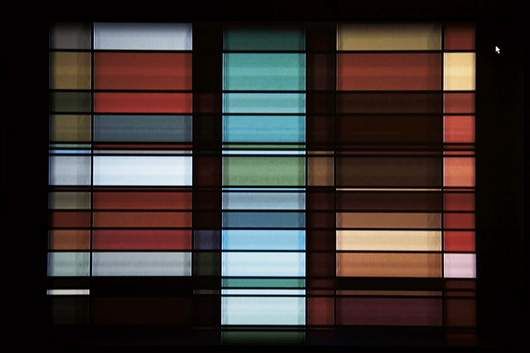
From “Jeremy Blake in Three Parts,” written by editor/curator Bennett Simpson for PS 1’s “Greater NY” show. In 2000, Blake’s 20-min. digitally animated abstraction titled Angel Dust was in both the harried, hasty “Greater NY” and the Pompidou’s “Elysian Fields”, a sublime show for which Simpson curated an incredible sound program:
I.
In the new art game, machine language is the best kind of pragmatism. Because you’ve never had so many options, your tools should work for you. There is still such an impoverished discourse around art made with “new media” that it benefits everyone to be dexterous (or at least flexible). Jeremy Blake tells me it took months to program his latest digital animation Angel Dust. I believe him. Line for line, the amount of coding, sequencing, and editing involved is staggering. As is more and more the case with art’s flirtation with technology, the hours logged and the efforts involved are right on the surface — and in a way, this is part of the point. Skill is transparent. Insofar as Angel Dust can be called abstract art, its abstraction is one of trial and error, micro-production, shortcuts, good fortune, lots of practice, lots of knowledge, and an appreciation of possibilities. I’m not only speaking about the animation’s formal qualities or its methods of production. If abstraction is now the domain of distributed and integrated systems of information, then the function of Angel Dust’s content — its seething Mondrian grid, its Burbank-rolled narrative tics, and its psychedelia — is no different from its code. Blake makes programmed art works: the what and how are symptomatic of each other.
The other two parts are after the jump. An edition of Angel Dust is coming up at auction at Phillips in a couple of weeks.
Solar Balloons Not Quite Satelloons
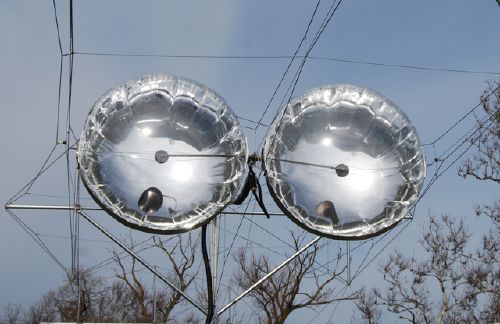
So I’m staring at these Solar Balloons by Coolearth Technology, caught like a deer in some headlights [actually, with this pair, maybe it’s “caught like a spring breaker in some headlights, but whatever], and I can’t figure them out.

Then I get it: one half of the balloon is clear; the parabolic–or parabola-like, anyway–reflector part is the inside surface of the other, opaque side of the balloon. 2-meter diameter. Not Satelloon-scale, but still, it’s good to know it’s out there.
Solar Balloons from Coolearth Technology [coolearthsolar via inhabitat]
From A Glimpse To A Panorama

If anyone’s life’s work could have at once so little and so much to show for it, it’s Agnes Martin. From Brian Droitcour for Artforum:
This brisk tour of Agnes Martin’s career–forty years in twenty drawings–is anchored by On a Clear Day, 1973, a series of prints offering thirty ways to regard the square.
…
In the 1970s, Martin pared down an already spare vocabulary. These prints are a glimpse of her shifting priorities, and the drawings around them protract that glimpse into a lifelong panorama.
From the gallery’s press release for the show, a little background:
In the late 1950’s Agnes Martin’s landscapes and biomorphic surrealist works transformed into abstraction and what would eventually become her signature examination of rectangular grids within a square format. Her work ranges from early tight grids to the opening up of forms to wider rectangles. Disillusioned with New York, Martin moved to New Mexico in 1967 and abandoned painting. When she resumed her work around 1974, the earlier primarily black and white palette modified to include monochromatic washes of subtle pastel colors, perhaps influenced by the New Mexico landscape. While Martin’s abstract repetitive forms have been associated with Minimalist style, she considered Minimalism impersonal and over-intellectual, preferring her work to be characterized as Abstract Expressionist due to its more personal and spiritual nature. Inspired by emerging concepts of Taoism and Zen Buddism in the 1950’s, Martin, like many of the Abstract Expressionists, sought a style that transcended the material world and spoke more of the mind and the experience of the sublime.
On A Clear Day was instrumental in Martin’s own retrospective re-evaluation of her work and was apparently a catalyst of sorts for her resumption of painting in 1974. For details, check out Lynne Cooke’s essay accompanying the Dia’s exhibition of pivotal paintings from 1974 – 1979.
Though it might be tempting, in the absence of any apparent content beyond the grids, to investigate and catalog the variations and details that were surely deliberate decisions on Martin’s part, Cooke argues that this is not what Martin was after when she began painting again:
her endeavor would not be to mobilize the viewer in a process of “looking for” but to immerse the solitary, stationary spectator in an indeterminate, luminous space, in attentive contemplation, “looking at.”
Brian Droitcour reviewing “Agnes Martin, Works On Paper” at Peter Blum Soho trough March 15 [artforum]
Peter Blum Gallery Soho [peterblumgallery]
“To The Islands, Agnes Martin Paintings, 1974-1979 [diacenter.org]
[image via portlandart.net]
To See This Weekend: John Powers @ Virgil deVoldere Gallery
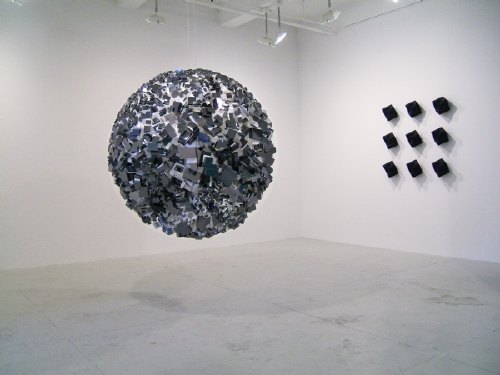
As he was working on it the last few months, my friend John Powers kept hinting that his upcoming show would have a bit of the Deathstar and a bit of the disintegrating disco ball. He’s not kidding. The Force is strong with this one.
Empire, 45-in diameter, styrofoam and anodized aluminum, at Virgil de Voldere Gallery, the Chelsea Arts Bldg on 26th st through Mar. 29 [virgilgallery.com]
John Powers’ portfolio site [johnpowers.us]
The Moon Museum
 Holy ^%$&! Man Smuggles Art To The &%#$ing Moon!
Holy ^%$&! Man Smuggles Art To The &%#$ing Moon!
In 2003, Craig Kalpakjian proposed a series of Earthworks-style drawings that would be executed on the surface of the moon, like the Nazca Lines or 60’s bad boys Michael Heizer’s and Dennis Oppenheim’s desert drawings. He called them Moonworks.
Now I find out there was already an entire Moon Museum, with drawings by six leading contemporary artists of the day: Andy Warhol, Robert Rauschenberg, David Novros, Forrest “Frosty” Myers, Claes Oldenburg, and John Chamberlain. The Moon Museum was supposedly installed on the moon in 1969 as part of the Apollo 12 mission.
I say supposedly, because NASA has no official record of it; according to Frosty Myers, the artist who initiated the project, the Moon Museum was secretly installed on a hatch on a leg of the Intrepid landing module with the help of an unnamed engineer at the Grumman Corporation after attempts to move the project forward through NASA’s official channels were unsuccessful.
Myers revealed the exhibition’s existence to the New York Times, which published the story Nov. 22, 1969, two days after the Apollo 12 crew had left the moon–and the Intrepid–and two days before they arrived back on earth. Here’s the photo from the story:
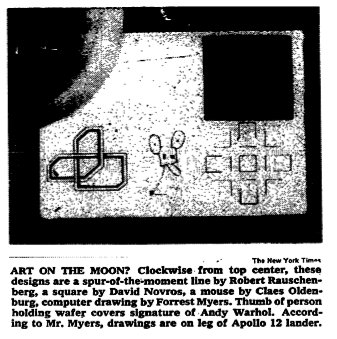
According to Myers, who was involved with E.A.T. on the Pepsi Pavilion project at the time, the six drawings were miniaturized and baked onto an iridium-plated ceramic wafer measuring just 3/4″ x 1/2″ x 1/40″, with the assistance of engineers at Bell Labs.
According to the Times, the artworks are, clockwise from the top center: Rauschenberg’s wavy line; Novros’ black square bisected by thin white lines [in 1969, Novros also created the incredibly rich, minimalist fresco on the second floor of Judd’s 101 Spring St]; a computer-generated drawing by Myers; a geometric mouse by Oldenburg, “the subject of a sculpture in his current show at the Museum of Modern Art” [a sculpture which is in MoMA’s permanent collection, btw]; and a template pattern by Chamberlain, “similar to one he used to produce paintings done with automobile lacquer.” Warhol’s contribution, which is obscured by the thumb above, is described as “a calligraphic squiggle made up of the initials of his signature.”
Actually, it’s a drawing of a penis. Here are some other photos by Frosty Myers, published, I believe, with a 1985 Omni Magazine article by the arts writer Phoebe Hoban. That would be the Warhol Penis there in the upper right.
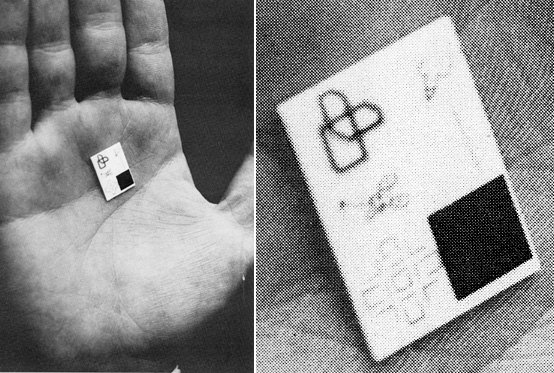
As the NASA spokesman told the Times when asked about the Museum infiltration, “I don’t know about it. If we had been asked, it sounds like something we’d have very much interested in [sic]. If it is true that they’ve succeeded in doing it by some clandestine means, I hope that the work represents the best in contemporary American art.”
[emphasis added for ironic amusement, though to Myers’ credit, it turned out to be a pretty good grouping of artists to have involved.]
But is it conceivable that someone could have smuggled dirty pictures onto a mission to the moon? Actually, yes. Even if Warhol hadn’t sent that penis to the moon, Apollo 12 would still have achieved the first known incident of lunar nudity.
The back-up crew for the A12 mission surreptitiously inserted reduced photos of Playboy centerfolds into the flight crew’s fireproof plastic cuff checklists which were only discovered about 2.5 hours into their first moon walk. [if you’re at work, that first link is to nasa.gov, and the second is to playboy.com. The same scans are available at both sites, though NASA has conveniently embedded theirs in a PDF.]
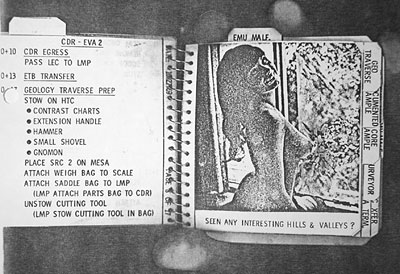
In addition to the six drawings, the Moon Museum also acquired a large collection of photographs; astronaut Alan Bean accidentally left several rolls of undeveloped film behind on the lunar surface. The checklists came back with the astronauts.
Related: Frosty Myers, the SoHo pioneer, had a retrospective exhibition last November-December at Friedman Benda Gallery in Chelsea. [friedmanbenda.com]
Also, he had a sitdown with my favorite crazy at The Grey Lady, design/home writer Joyce Wadler. [nyt]
No Kidding, It’s A Small World
After riding the It’s a Small World ride half a dozen times on my first trip to Disneyland, I sent off for information on how to become an Imagineer. I was seven.
Yet somehow it’s taken me until this week to realize that the treacly animatronic Mary Blair masterpiece was originally created by Walt Disney at the behest of the Pepsi-Cola Corporation, which wanted a popular pavilion for the 1964 New York World’s Fair. Disney was apparently commissioned to design four corporate pavilions that fair.
According to Billy Kluver’s long, rambling account/apologia published in the 1972 book, Pavilion, Pepsi was in talks with Disney to produce the 1970 pavilion in Osaka, too, but Disney’s budgets were orders of magnitude too high. Disney’s withdrawal in late 1968 left Pepsi with an empty pavilion to fill, and it created the opportunity for E.A.T. to get involved.
It’s a small world after all.
Joep van Lieshout: Those Who Can’t Do, Make Art
Now I’ve been a fan of Joep van Lieshout’s work for a long time, even if a lot of it’s too irreverent or too bombastically oversexualized to evangelize about regularly. [“You see, mom, he builds these room-sized uteruses with built-in bars…”]
But listening to his talk at Tate Modern last fall, it wasn’t his successes so much as his failures that stuck in my mind. The arc of the interview with curator Marcus Verhagen was the failure of AVL-Ville, Atelier Van Lieshout’s attempt to turn its Rotterdam waterfront studio complex into an independent, anarchic state, and how that flirtation with utopianism eventually led to the artist’s current dystopian fascination. The artist then explained his concept for a hyper-capitalist, sustainable, totalitarian slave city with a population of 200,000 that produces EUR7 billion in profits each year. So far so good [sic].
When it got to the Q&A, though, someone asked van Lieshout if his zero-impact utopia, with its organic urban farming, &c., was so great, why not keep developing it? He dismissed the idea, since it would involve actually running the thing, then it’d take expertise, and attention, and involvement with the bureaucracy, and anyway, who knows if it really works? [Obviously, I’m paraphrasing here.]
The gist of his reply, though, was reality’s too hard, so he’s leaving it as art.
Then when someone lobbed a generous softball of a question by describing his structures and installations as “cinematic,” van Lieshout punted again. Though he, too, conceives of his work as the sets upon which some unspecified drama unfolds, he never makes films, because he “doesn’t know how.”
I’d always thought of AVL-Ville as something of a conceit, but I had no idea how utterly dependent it was on the benign neglect of Dutch bureaucrats, and I certainly didn’t know how quickly and utterly it folded when faced with the most rudimentary challenge. And similarly, when even a clueless yahoo like me can figure out how to make a movie, expertise and technology just are not credible obstacles anymore.
Sure, art is not, by definition, the real world, but I’d always somehow considered it to be superior in its distinctiveness. And yet here was van Lieshout’s art being defined by its impractical, unproved inferiority in one case, and as the refuge for ignorance in another. We unconsciously give Art a presumption of cultural significance that, what do you know, it may not automatically deserve.
Too often, it gets considered only on its own terms, in a bubble, a world [sic] apart from the real world. It’s why the mediocrity of an artist like Mariko Mori gets taken seriously when it’s dwarfed technically and philosophically by CG and narratives of the best films and video games. Or why a piddly little spiral jetty is raised to masterpiece status while the US Army’s vast earthworks at the nearby Dugway Proving Grounds are ignored and detested. There’ll be a reckoning some day, a reality check, and a lot of art that was considered intrinsically valuable or important will end up as worthless oddities, like 19th century jewelry made from that most rare of metals at the time, aluminum.
Talking Art | Joep van Lieshout [tate.org.uk via imomus]

